Making art experiences more accessible
Our galleries are filled with art that delights, challenges, and connects visitors. Yet for the over 100,000 Oregonians who are blind and low vision, art is often inaccessible. We aim to make art accessible to all visitors.
Visitors can check out a variety of assistive technology free of charge. These include magnification sheets, a lighted magnifier, a flashlight, an iPad with magnification, and multiple EnChroma glasses, which help increase color vision for those with red/green color blindness.
The Bloomberg Connects app offers a variety of audio guides for special exhibitions. Accessible digital labels and wall text can be found on the exhibition webpages along with image descriptions for many of the objects.
Visitors attending events can request guiding and audio description. In the future we aim to revive in-person and virtual “Sensing Art” tours that provide verbal descriptions, multisensory interaction, and group discussions and engagements.
3D Tactile Graphics by Michael Cantino
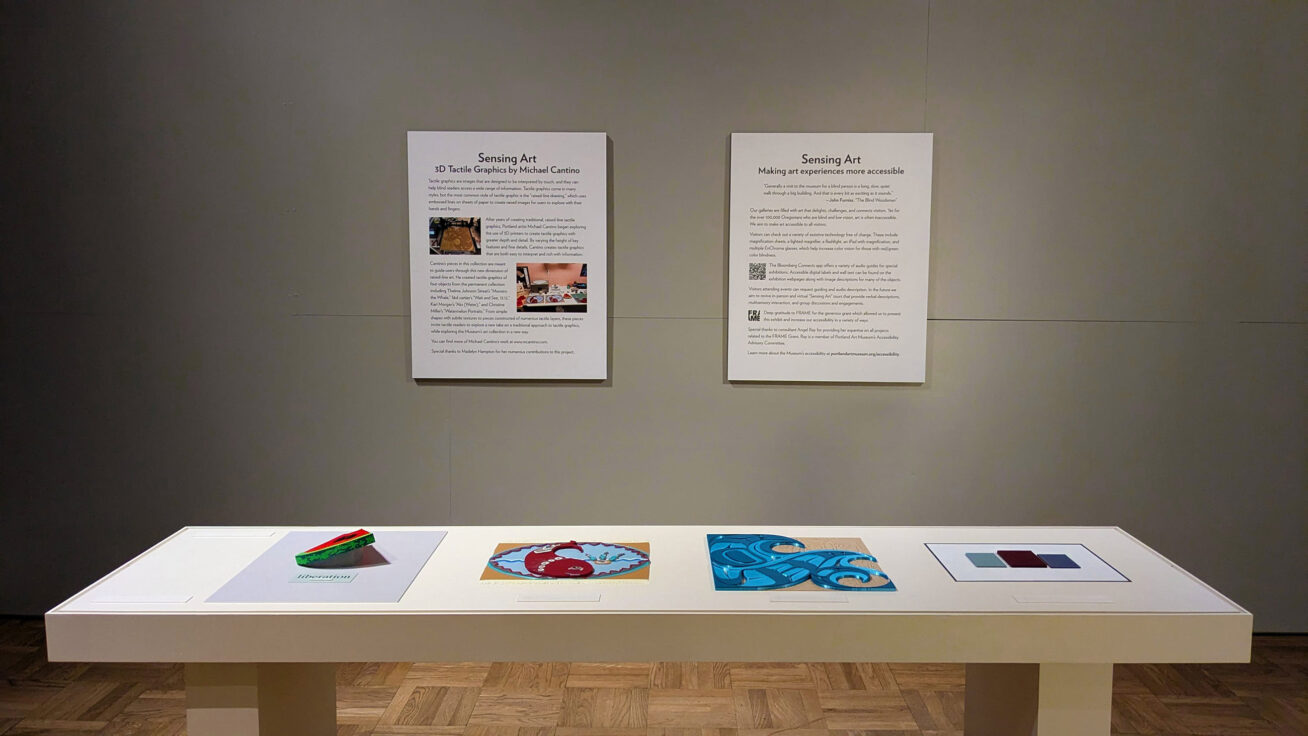
Tactile graphics are images that are designed to be interpreted by touch, and they can help blind readers access a wide range of information. Tactile graphics come in many styles, but the most common style of tactile graphic is the “raised-line drawing,” which uses embossed lines on sheets of paper to create raised images for users to explore with their hands and fingers.
After years of creating traditional, raised-line tactile graphics, Portland artist Michael Cantino began exploring the use of 3D printers to create tactile graphics with greater depth and detail. By varying the height of key features and fine details, Cantino creates tactile graphics that are both easy to interpret and rich with information.
Cantino’s pieces in this collection are meant to guide users through this new dimension of raised-line art. He created tactile graphics of four objects from the permanent collection including Thelma Johnson Streat’s “Monstro the Whale,” f&d cartier’s “Wait and See, 13.12,” Kari Morgan’s “Aks (Water),” and Christine Miller’s “Watermelon Portraits.” From simple shapes with subtle textures to pieces constructed of numerous tactile layers, these pieces invite tactile readers to explore a new take on a traditional approach to tactile graphics, while exploring the Museum’s art collection in a new way.
Tactile Graphic of Christine Miller’s Watermelon Portraits, 2022.
Created by Michael Cantino, 2023.
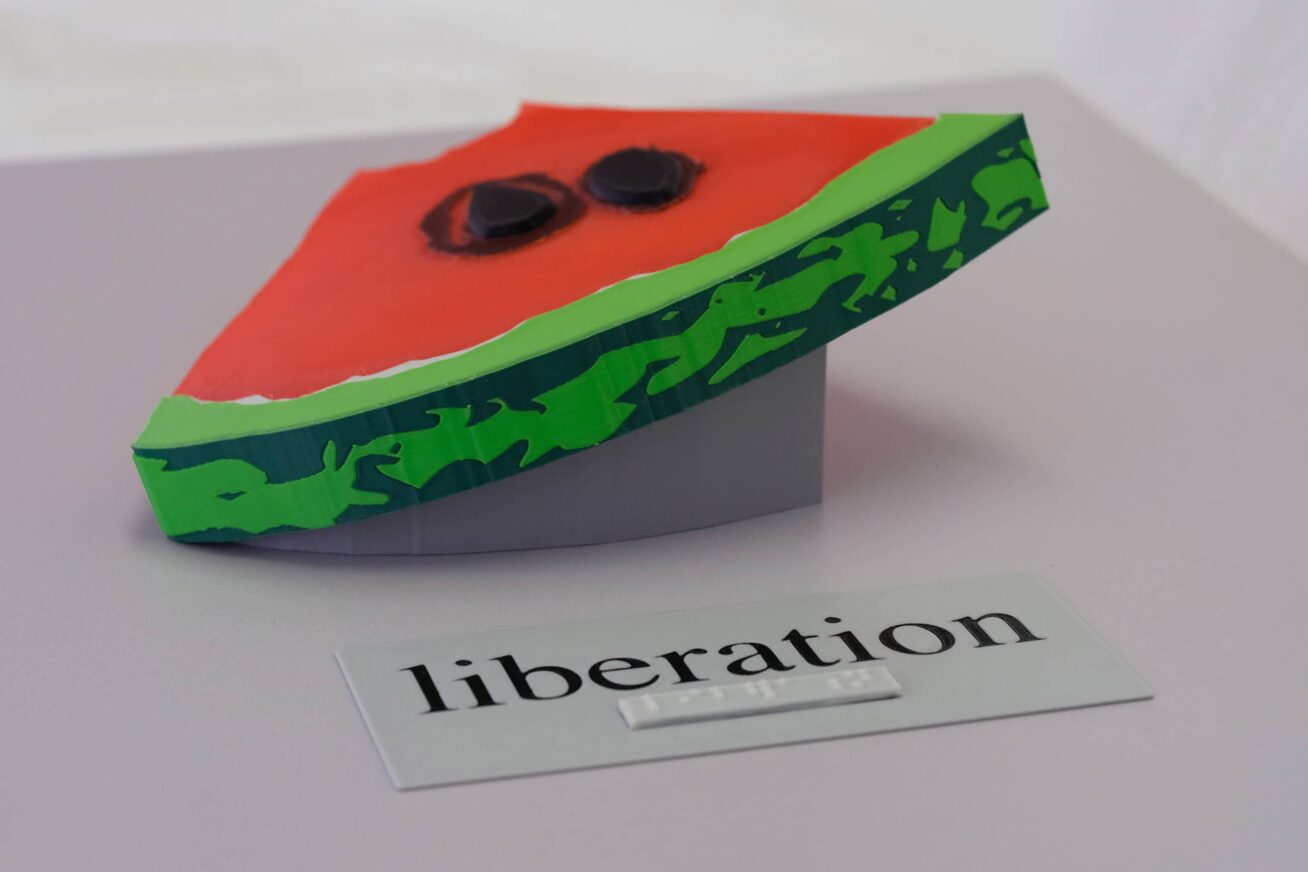
Christine Miller
American, born 1990
Watermelon Portraits, 2022
Watercolor and ink on paper
Museum Purchase, 2022.56.6
Miller’s work focuses on the design intentionality of physical products, literature, and advertisements that have been used to dehumanize African Americans. Her art centers around racial stereotypes and histories, while simultaneously reframing cultural narratives. Pointedly exploring how anti-Black propaganda and stereotypes permeate American life, Miller sources and recontextualizes figurines, advertisements, written material, and other ephemera that overtly and covertly create and maintain anti-Blackness. Despite the deeply violent and sinister nature of these objects and visuals, Miller often draws from those with an “everyday” quality – once readily available tchotchkes, drugstore products, and popular magazines – that add to the material’s impact. Through her work, Miller confronts and challenges white supremacist definitions and illustrations of Blackness, as well as her own identity formation.
[Image Description of Original Object: Portrait-oriented watercolor painting of a slice of watermelon standing on its rind with a bite taken out of the top. The rind consists of variegated green with a yellow portion above it. There is a small white line between the yellow and the variegated red meat. Two black seeds sit in the middle, one slightly larger pointing up and the second to the right pointing down. The slice is angled slightly to the left. The word liberation is printed below in lowercase gray letters.]
[Image Description of Tactile: 3-D printed replica of a slice of watermelon. The rind is variegated green. There is a small white strip between the green rind and the red meat. There are two black seeds in the middle, the one on the left points up and the one on the right points down. There is a bite taken out of the top of the slice. It is mounted with a small wedge under it. Below the slice is a gray sign spelling liberation in black lowercase letters with a Braille label spelling liberation below. Both the watermelon and the title are secured on a smooth gray rectangle.]
Tactile Graphic of Thelma Johnson Streat’s Monstro the Whale, 1940.
Created by Michael Cantino, 2023.
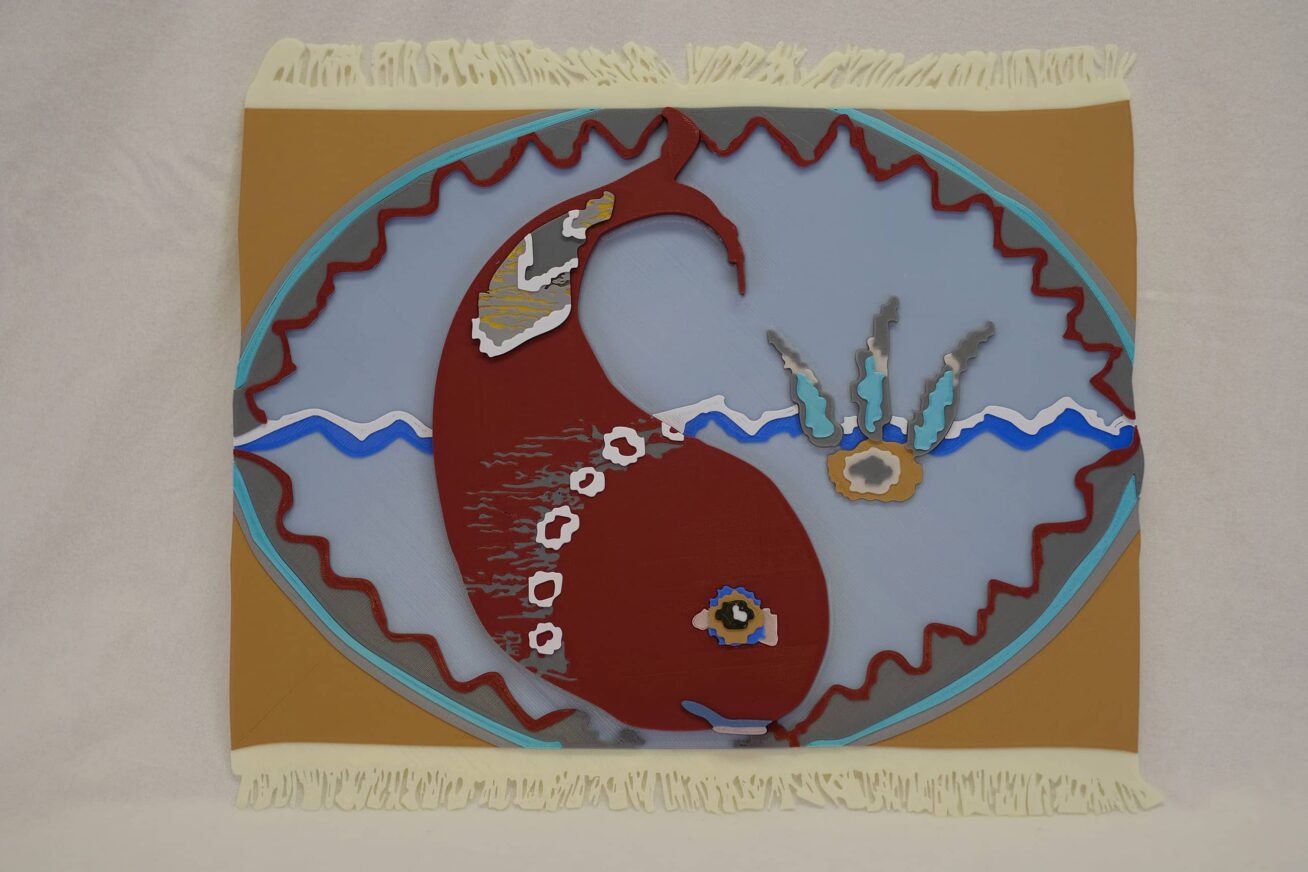
Thelma Johnson Streat
American, born 1912
Monstro the Whale, 1940
Wool
Courtesy of the Fine Arts Collection, U.S. General Services Administration. New Deal Art Project. L42.32.1
Streat grew up in Portland and studied at the Museum Art School in the 1930s. She was a dancer, singer, painter, and textile artist. Streat was the first Black woman artist to have a painting included in the Museum of Modern Art’s permanent collection. She worked with Mexican muralist Diego Rivera on his Pan American Unity mural for the federal Works Progress Administration in San Francisco in 1939, and her own WPA mural Medicine and Transportation resides in the Smithsonian’s National Museum of African American History & Culture.
[Image Description of Original Object: Landscape-oriented wool tapestry. Orange rectangular tapestry with a cream line and tassels at the top and bottom. In the center a light blue oval fills the frame. It is outlined with thin white and blue lines on the outside and brownish shapes like mountains with a red line on top on the inside facing the center. A blue jagged line with a thin white line on top appears as waves across the middle of the oval. A large red whale fills the oval from top to bottom with its large head near the bottom, curved body in the center, and its small flukes at the top with the left edge overlapping the mountain-like border. The whale has a dark eye with white in the middle and an orange and brown border. It has a blue and brown line for a mouth. About one third down the whale’s body from the head are six small white circles in a line with gray threads extending in lines out from them. Near the tail the whale has three cream v-shaped lines with yellow and gray thread between them. Floating to the right of the whale is a brown oval with a dark brown center outlined by a thin cream line. Three feather-like shapes with teal centers and brown, cream, and red outlines protrude from the top of the oval.]
[Image Description of Tactile: Landscape-oriented rectangle. Top and bottom edges are cream colored fringes. The main portion of the tapestry has a brown background. A large light blue oval fills the tapestry boarded by gray mountain-like shapes outlined in red with a thin teal border along the outside of the oval. A blue wavy line resembling waves with a thin white line above it extends through the center of the oval. A large burgundy whale fills the left side of the oval. Its eye has a brown outline, brown layer, and a black center with small white patches in the middle and to each side. Near the back of the head is a line of six white asymmetric circles with gray streaks extending to the left. On the tail, just under the flukes, are three loosely v shaped white lines that get smaller towards the tail. The bottom one has a patch of gray that continues until the next white line. The second has a patch of blue. The third has a small patch of gray. To the right of the whale’s head is a small tan oval with a black center outlined in white. There are three feather-like shapes that extend from the top of the circle that are blue and outlined in burgundy with white highlights along the borders.]
Tactile Graphic of Kari Morgan’s Aks (Water), 2021.
Created by Michael Cantino, 2023.
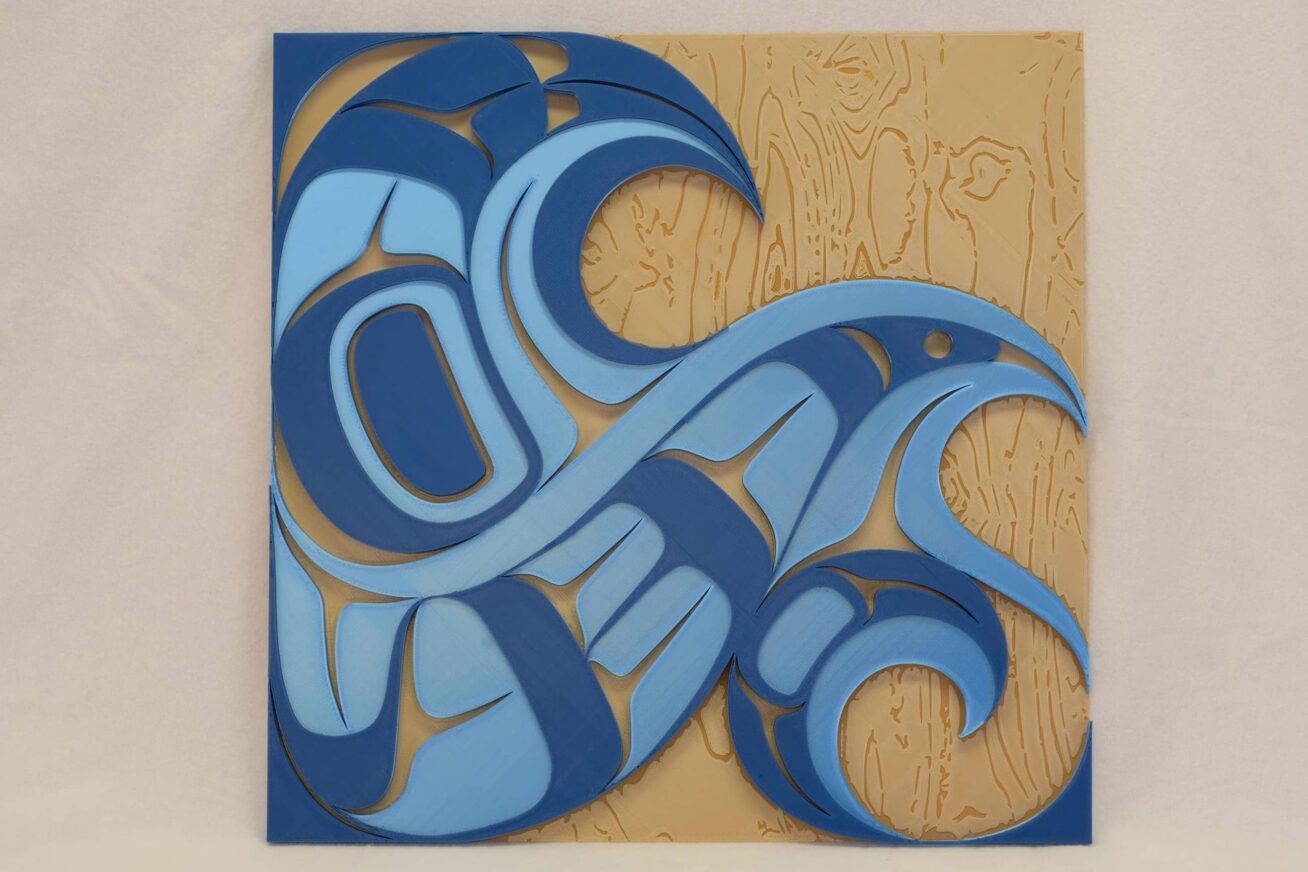
Kari Morgan
Canadian, born 1989
Aks (Water), 2021
Acrylic on birch
Museum Purchase, funds provided by Mary Sayler. 2022.16.1
This beautiful adaptation of traditional Northwest Coast design by the Nisga’a artist represents where we as physical beings will return one day. The design has a clear fluid movement to it, the calming colors have a distinct contrast to the large waves that embody an ultimate untamable force. This piece expresses the true feeling of home on the coast.
[Image Description for Original Object: Square acrylic painting on plain birch board. Traditional indigenous designs combine to form a bird that resembles a series of waves, left wing outstretched and right one pulled close to its body in a circular shape. Its beak touches the right edge, wings touch the top and bottom, and the body borders the left side with the tail out of view. Broad clean lines form the shapes with just two variations of blue – one lighter and one darker. The artist’s signature appears at the bottom in the same dark blue – K Morgan.]
[Image Description for Tactile: The tactile is a nearly identical representation of the original and is also composed of only two colors of blue. The dark blue is represented with smooth material while the light blue has textured lines. The grain of the wood is represented on the board.]
Tactile Graphic of f&d cartier’s Wait and See, 12.12
Created by Michael Cantino, 2023.
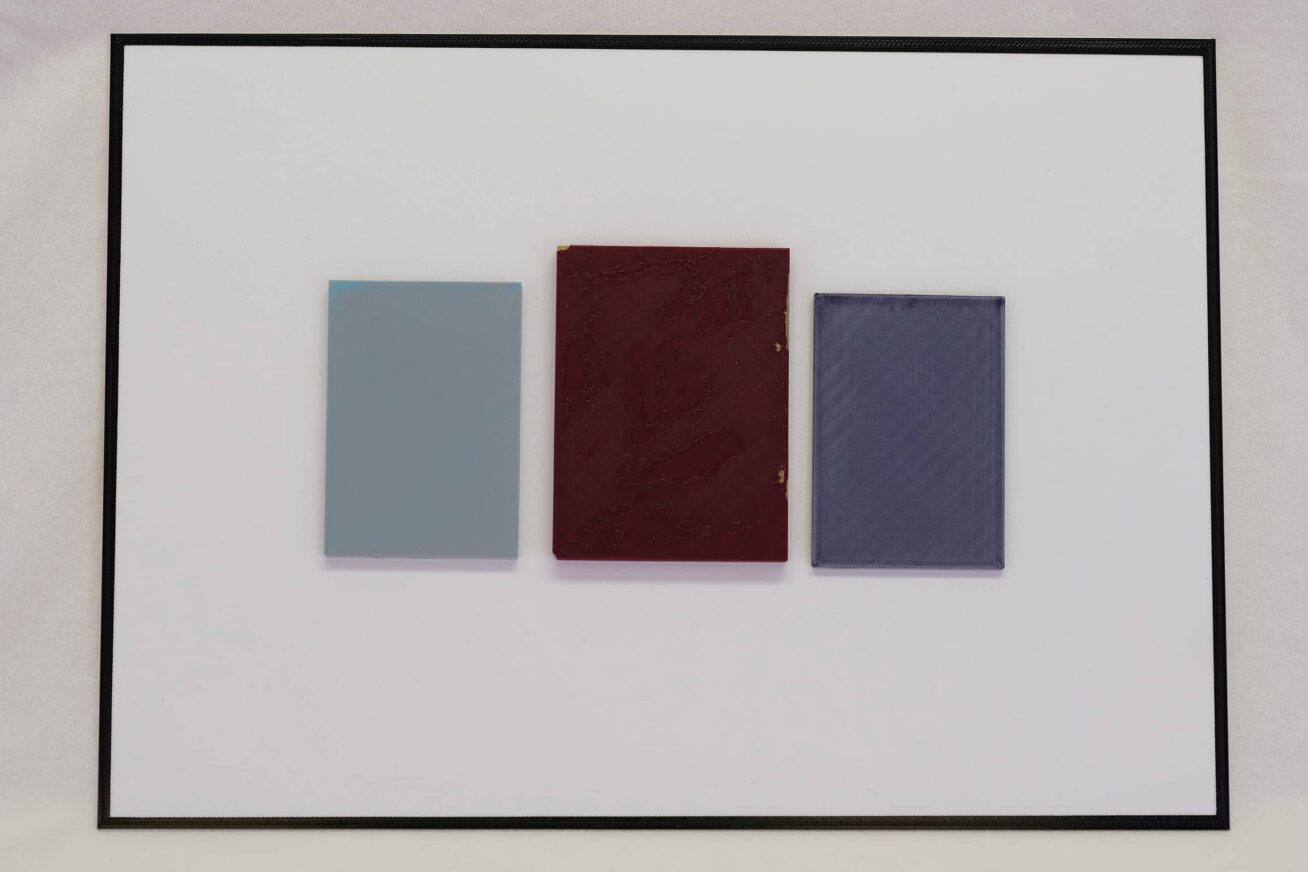
f&d cartier
Swiss, born 1952,1950
Wait and See, 12.12, 2013
Luminogram
The Blue Sky Gallery Collection. Gift of Christopher Rauschenberg. 2014.104.1a-c
Artistic team f&d cartier use unprocessed, industrially produced photographic papers to create their clean and minimal Wait and See collages. Because these papers, which are embedded with light-sensitive silver salts, have not been treated in a stop bath or fixer—the chemical processes that wash away the unexposed silver salts and stop the image from additional developing—they will continue to change and darken. These cameraless works point to the fragile nature of the photograph and of memory, which morph as time passes.
[Image Description for Original Object: Luminogram consisting of three vertical rectangles. Two smaller gray rectangles flank a burgundy rectangle. While from a distance they appear to be one solid color, upon closer inspection you can see slight color variations and textures under the surface.]
[Image Description of Tactile: Tactile graphic of luminogram consisting of three vertical rectangles mounted on a white rectangle with a thin black border. Two smaller gray rectangles flank a burgundy rectangle. While from a distance they appear to be one solid color, upon closer inspection you can see slight color variations and textures under the surface.]
You can find more of Michael Cantino’s work at www.mcantino.com.
Special thanks to Madelyn Hampton for her numerous contributions to this project.
Resources
Acknowledgements
Deep gratitude to FRAME for the generous grant which allowed us to present this exhibit and increase our accessibility in a variety of ways.
Special thanks to consultant Angel Ray for providing her expertise on all projects related to the FRAME Grant. Ray is a member of Portland Art Museum’s Accessibility Advisory Committee.